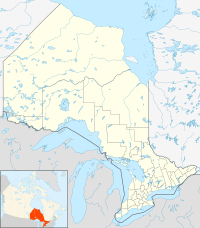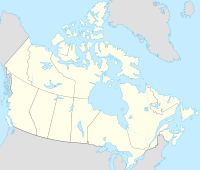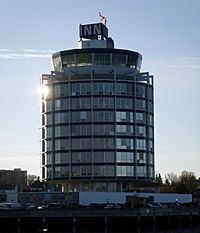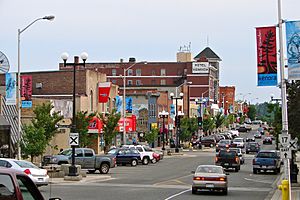Kenora facts for kids
Quick facts for kids
Kenora
|
|
|---|---|
| City of Kenora | |
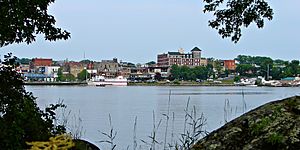 |
|
| Nickname(s):
K-Town
|
|
| Country | Canada |
| Province | Ontario |
| Incorporated (town) | 1882 as Rat Portage |
| Renamed | 1905 as Kenora |
| Amalgamated (City) | 2000 |
| Area | |
| • Land | 211.59 km2 (81.70 sq mi) |
| Elevation | 409.70 m (1,344.16 ft) |
| Population
(2021)
|
|
| • Total | 14,967 |
| • Density | 71.3/km2 (185/sq mi) |
| Time zone | UTC−06:00 (CST) |
| • Summer (DST) | UTC−05:00 (CDT) |
| Forward sortation area |
P9N
|
| Area code(s) | 807 |
| Website | www.kenora.ca |
Kenora, previously named Rat Portage (French: Portage-aux-Rats), is a small city situated on the Lake of the Woods in Ontario, Canada, close to the Manitoba boundary, and about 210 km (130 mi) east of Winnipeg by road. It is the seat of Kenora District.
The history of the name extends beyond the time of white settlers arriving in the region. The name Rat Portage had its origin in the Ojibwa name Waszush Onigum, which roughly translated, means portage to the country of the muskrats. A shortened and somewhat corrupted version, Rat Portage, was adopted by the Hudson’s Bay Company in naming their post, then located on Old Fort Island on the Winnipeg River. When the post was moved to the mainland and a town grew up around it, the name Rat Portage was assumed by the community.
The town of Rat Portage was renamed in 1905 by using the first two letters of itself and the neighbouring towns of Keewatin and Norman to form the present-day City of Kenora. In 2001, the towns of Kenora and Keewatin as well as the unincorporated communities of Norman and Jaffray Melick amalgamated under the Municipal Act, 2001.
Kenora is the administrative headquarters of the Anishinabe of Wauzhushk Onigum, Obashkaandagaang Bay, and Washagamis Bay First Nations band governments.
Contents
Etymology
The name "Kenora" was coined by combining the first two letters of Keewatin, Norman and Rat Portage.
History
Kenora's future site was in the territory of the Ojibway when the first European, Jacques De Noyon, sighted Lake of the Woods in 1688.
Pierre La Vérendrye established a secure French trading post, Fort St. Charles, to the south of present-day Kenora near the current Canada/U.S. border in 1732, and France maintained the post until 1763 when it lost the territory to the British in the Seven Years' War — until then, it was the most northwesterly settlement of New France. In 1836 the Hudson's Bay Company established a post on Old Fort Island, and in 1861, the Company opened a post on the mainland at Kenora's current location.
In 1878, the company surveyed lots for the permanent settlement of Rat Portage ("portage to the country of the muskrat") — the community kept that name until 1905, when it was renamed Kenora.
Kenora was once claimed as part of the Province of Manitoba, and there are early references to Rat Portage, Manitoba. There was a long lasting argument between the two provinces known as the Ontario-Manitoba boundary dispute. Each province claimed the town as part of their territory and the dispute lasted from 1870 to 1884. Although Ottawa had ruled the town part of Manitoba in 1881, the issue was finally taken up with the Judicial Committee of the Privy Council which eventually decided in Ontario's favour. Kenora officially became part of the province of Ontario in 1889. Boundaries were drawn up for the provinces and the Northwest Angle on Lake of the Woods which definitively drew the borders between Ontario, Manitoba, Canada, and Minnesota, U.S.A.
Gold and the railroad were both important in the community's early history: gold was first discovered in the area in 1850, and by 1893, 20 mines were operating within 24 km (15 mi) of Rat Portage, and the first Canadian ocean-to-ocean train passed through in 1886 on the Canadian Pacific Railway. Among the entrepreneurs attracted to the town was the Hon. JEP Vereker, a retired British army officer and youngest son of the 4th Viscount Gort.
Later, a highway was built through Kenora in 1932, becoming part of Canada's first coast-to-coast highway in 1943, and then part of the Trans-Canada Highway, placing the community on both of Canada's major transcontinental transportation routes. The original barrier to the completion of the highway concerned the crossing of the Winnipeg River at two locations. The single span arch bridges are among the longest of their type in North America.
During the Prohibition era in the United States, the Lake of the Woods served as a smuggler's route for the transport of alcohol.
In December 1883, there was a large fire in Rat Portage, rendering 70 of the town's then population of 700 homeless.
The Stanley Cup was won by the Kenora Thistles hockey team in 1907. The team featured such Hall of Famers as Billy McGimsie, Tommy Phillips, Roxy Beaudro, and Art Ross, for whom the Art Ross Trophy is named. Kenora is the smallest town to have won a major North American sports title.
Rat Portage is mentioned in Algernon Blackwood's famous 1910 story, "The Wendigo".
In 1967, the year of the Canadian Centennial, Kenora erected a sculpture known as Husky the Muskie. It has become the town's mascot and one of its most recognizable features.
A dramatic bank robbery took place in Kenora on May 10, 1973. An unknown man entered the Canadian Imperial Bank of Commerce heavily armed and wearing a "dead man's switch", a device utilising a clothespin, wires, battery and dynamite, where the user holds the clothespin in the mouth, exerting force on the clothespin. Should the user release the clothespin, two wires attached to both sides of the pin complete an electrical circuit, sending current from the battery, detonating the explosives. After robbing the bank, the robber exited the CIBC, and was preparing to enter a city vehicle driven by undercover police officer Don Milliard. A sniper, Robert Letain, positioned across the street, shot the robber, causing the explosives to detonate and kill the robber. Most of the windows on the shops on the main street were shattered as a result of the blast. Recently, Kenora Police submitted DNA samples from the robber's remains to a national database to identify him; however, the suspect was never positively identified.
The importance of the logging industry declined in the second part of the 20th century, and the last log boom was towed into Kenora in 1985. The tourist and recreation industries have become more important.
Geography
Neighbourhoods
In addition to the formerly separate towns of Keewatin and Jaffray Melick, the city also includes the neighbourhoods of Norman, Rabbit Lake, Rideout, Pinecrest, Minto and Lakeside.
Keewatin currently forms the western-most section of the City of Kenora. Norman was a small community located halfway between the village of Keewatin and Rat Portage. The Village of Keewatin was founded in 1877 while the Village of Norman was founded in 1892; both communities amalgamated with Rat Portage in 1905 to form the Township of Kenora. Keewatin eventually separated and was founded as a Township in 1908.
The Jaffray Melick neighbourhood currently delineates the north-eastern most section of the City of Kenora. The Township of Jaffray was founded in 1894 and the Township of Melick in 1902; the two townships were amalgamated in 1908 as Jaffray and Melick, and renamed as Jaffray Melick in 1911. Compared to Keewatin, Norman, and Rat Portage, Jaffray Melick is the most rural community, with few retail stores and one golf course, Beauty Bay, on Black Sturgeon lake.
Climate
Kenora has a humid continental climate (Köppen climate classification Dfb) with warm summers and cold, dry winters. Its climate is influenced by continental air masses. Winters are cold with a January high of −11 °C (12.2 °F) and a low of −21 °C (−5.8 °F). Temperatures below −20 °C (−4.0 °F) occur on 45 days. The average annual snowfall is 158 centimetres (62 in), which is lower than places to the east as it is influenced by the dry air of continental high pressure zones, resulting in relatively dry winters. Summers are warm with a July high of 24 °C (75.2 °F) and a low of 15 °C (59.0 °F) and temperatures above 30 °C (86.0 °F) occur on 5.3 days. The average annual precipitation is 662 millimetres (26 in), with most of it being concentrated in the summer months with June being the wettest month and February the driest.
The highest temperature ever recorded in Kenora was 40.6 °C (105 °F) on 11 July 1936. The coldest temperature ever recorded was −43.9 °C (−47 °F) on 20 January 1943.
| Climate data for Kenora Airport, 1981−2010 normals, extremes 1899−present | |||||||||||||
|---|---|---|---|---|---|---|---|---|---|---|---|---|---|
| Month | Jan | Feb | Mar | Apr | May | Jun | Jul | Aug | Sep | Oct | Nov | Dec | Year |
| Record high humidex | 9.0 | 8.5 | 27.0 | 30.0 | 39.3 | 41.2 | 43.2 | 41.6 | 41.6 | 28.9 | 18.9 | 8.7 | 43.2 |
| Record high °C (°F) | 9.1 (48.4) |
8.8 (47.8) |
23.8 (74.8) |
30.6 (87.1) |
35.4 (95.7) |
37.2 (99.0) |
40.6 (105.1) |
35.0 (95.0) |
34.6 (94.3) |
26.7 (80.1) |
19.4 (66.9) |
9.4 (48.9) |
40.6 (105.1) |
| Average high °C (°F) | −11.4 (11.5) |
−7.6 (18.3) |
−0.2 (31.6) |
9.4 (48.9) |
16.7 (62.1) |
21.7 (71.1) |
24.4 (75.9) |
23.4 (74.1) |
17.1 (62.8) |
8.8 (47.8) |
−0.9 (30.4) |
−9.2 (15.4) |
7.7 (45.9) |
| Daily mean °C (°F) | −16 (3) |
−12.5 (9.5) |
−5.2 (22.6) |
4.1 (39.4) |
11.3 (52.3) |
16.8 (62.2) |
19.7 (67.5) |
18.6 (65.5) |
12.7 (54.9) |
5.1 (41.2) |
−4.2 (24.4) |
−13.1 (8.4) |
3.1 (37.6) |
| Average low °C (°F) | −20.5 (−4.9) |
−17.4 (0.7) |
−10.1 (13.8) |
−1.3 (29.7) |
5.8 (42.4) |
11.8 (53.2) |
14.9 (58.8) |
13.9 (57.0) |
8.3 (46.9) |
1.4 (34.5) |
−7.4 (18.7) |
−17.1 (1.2) |
−1.5 (29.3) |
| Record low °C (°F) | −43.9 (−47.0) |
−43.3 (−45.9) |
−36.1 (−33.0) |
−27.2 (−17.0) |
−12.2 (10.0) |
−1.1 (30.0) |
3.9 (39.0) |
−1.7 (28.9) |
−6.7 (19.9) |
−20 (−4) |
−31.3 (−24.3) |
−41.1 (−42.0) |
−43.9 (−47.0) |
| Record low wind chill | −57.5 | −54.3 | −46.7 | −37.7 | −20.5 | −4.2 | 0.0 | 0.0 | −12.6 | −22.2 | −46.8 | −51.5 | −57.5 |
| Average precipitation mm (inches) | 25.6 (1.01) |
19.4 (0.76) |
28.1 (1.11) |
36.3 (1.43) |
80.8 (3.18) |
118.7 (4.67) |
103.4 (4.07) |
84.2 (3.31) |
85.6 (3.37) |
62.6 (2.46) |
42.1 (1.66) |
28.3 (1.11) |
715.0 (28.15) |
| Average rainfall mm (inches) | 0.7 (0.03) |
3.0 (0.12) |
8.5 (0.33) |
22.4 (0.88) |
77.4 (3.05) |
118.6 (4.67) |
103.4 (4.07) |
84.2 (3.31) |
84.6 (3.33) |
49.4 (1.94) |
12.0 (0.47) |
1.1 (0.04) |
565.3 (22.26) |
| Average snowfall cm (inches) | 28.4 (11.2) |
18.6 (7.3) |
21.1 (8.3) |
14.6 (5.7) |
3.5 (1.4) |
0.1 (0.0) |
0.0 (0.0) |
0.0 (0.0) |
0.8 (0.3) |
14.2 (5.6) |
32.2 (12.7) |
30.6 (12.0) |
164.1 (64.6) |
| Average precipitation days (≥ 0.2 mm) | 13.4 | 10.9 | 10.5 | 9.0 | 12.9 | 14.5 | 13.3 | 12.2 | 13.0 | 13.7 | 14.0 | 15.6 | 152.9 |
| Average rainy days (≥ 0.2 mm) | 0.50 | 1.1 | 2.9 | 5.6 | 12.1 | 14.5 | 13.3 | 12.2 | 12.9 | 10.1 | 3.6 | 0.83 | 89.5 |
| Average snowy days (≥ 0.2 cm) | 13.8 | 10.7 | 8.9 | 4.8 | 1.5 | 0.10 | 0.0 | 0.0 | 0.47 | 5.5 | 12.4 | 15.5 | 73.7 |
| Source: Environment Canada, Extremes for Kenora 1899-1939 | |||||||||||||
Demographics
| Historical population | ||
|---|---|---|
| Year | Pop. | ±% |
| 1891 | 1,806 | — |
| 1901 | 5,202 | +188.0% |
| 1911 | 6,158 | +18.4% |
| 1921 | 5,407 | −12.2% |
| 1931 | 6,766 | +25.1% |
| 1941 | 7,672 | +13.4% |
| 1951 | 8,695 | +13.3% |
| 1961 | 10,904 | +25.4% |
| 1971 | 10,952 | +0.4% |
| 1981 | 9,817 | −10.4% |
| 1991 | 9,782 | −0.4% |
| 1996 | 10,063 | +2.9% |
| 2001 | 15,838 | +57.4% |
| 2006 | 15,177 | −4.2% |
| 2011 | 15,348 | +1.1% |
| 2016 | 15,096 | −1.6% |
| The population change between 1996 and 2001 reflects Kenora's amalgamation in 2000. | ||
In the 2021 Census of Population conducted by Statistics Canada, Kenora had a population of 14,967 living in 6,510 of its 7,637 total private dwellings, a change of -0.9% from its 2016 population of 15,096. With a land area of 211.65 km2 (81.72 sq mi), it had a population density of 70.7/km2 (183/sq mi) in 2021.
The median household income in 2005 for Kenora was $59,946, which is slightly below the Ontario provincial average of $60,455.
| Canada 2016 Census | Population | % of Total Population | |
|---|---|---|---|
| Visible minority group Source: |
Filipino | 140 | 0.9 |
| South Asian | 45 | 0.3 | |
| Black | 45 | 0.3 | |
| Chinese | 40 | 0.3 | |
| Latin American | 20 | 0.1 | |
| Japanese | 20 | 0.1 | |
| Other or mixed visible minority | 50 | 0.3 | |
| Total visible minority population | 355 | 2.4 | |
| Aboriginal group Source: |
First Nations | 1,610 | 10.9 |
| Métis | 1,495 | 10.1 | |
| Inuit | 10 | 0.1 | |
| Total Aboriginal population | 3,150 | 21.3 | |
| European | 11,285 | 76.3 | |
| Total population | 14,790 | 100 | |
Arts and culture
The city's most prominent cultural venue is the downtown Harbourfront, a park on the shore of Lake of the Woods which hosts the city's annual winter and summer festivals, as well as concert series, and other special events.
Kenora is home to Huskie the Muskie, a 40 ft. statue of a fighting muskellunge. Huskie the Muskie is situated in McLeod Park at the northernmost tip of Lake of the Woods.
The city's downtown core has a public arts project, with 20 murals depicting the region's history painted on buildings in the business district.
The city is home to a major international bass fishing tournament.
Kenora is sometimes stereotyped as an archetypal hoser community, evidenced by the phrase "Kenora dinner jacket" as a nickname for a hoser's flannel shirt.
The City of Kenora is home to the Lake of the Woods Museum, which has won awards from the Ontario Historical Society and the Ontario Museum Association for its exhibits and programming. It was called "one of the coolest little museums in Canada" by the CAA. In June 2011, the Museum was recognized by the Ontario Historical Society for its exhibit, Bakaan nake'ii ngii-izhi-gakinoo'amaagoomin (We Were Taught Differently): The Indian Residential School Experience, based on stories of residential school life told by local residents. Most recently the museum in 2012 the museum was awarded the 2012 Ontario Museum Association Award of Excellence in Special Projects for its work on the IPad based "mobile tour".
Military presence
The federal government maintains an armoury (Kenora Armoury at 800-11th Avenue North) in Kenora for the 116th Independent Field Battery, RCA.
Economy
Forestry, tourism and mining are the three largest sectors of the Kenora economy. The population balloons in the spring and summer to almost double the normal population when summer residents move in. The Lake of the Woods and numerous smaller lakes situated all around Kenora are the major draw for cottagers who summer here. Many are from the neighbouring province of Manitoba and the state of Minnesota.
Tourism
Kenora, a site of natural attractions, has visitors from all over the world year round. In the summer months visitors come to the area to undertake activities including swimming, biking, fishing, hiking, and boating. Kenora's tourist industry is also active during the winter months as visitors come not only to observe its natural environment but also to partake in ice fishing, snowboarding, skiing (both downhill and cross country) and snowmachining.
Kenora has two travel information centres. One is the newly renovated (2011) pavilion, located on the Harbourfront (the blue and grey building on Bernier Dr). The second information centre, called the Discovery Centre, opened July 22, 2011, and serves visitors year-round from its location at 931 Lake View Drive (just off of highway 17 West aka the Trans Canada highway).
Education
Two school boards and a community college function in the Kenora Area.
The Keewatin-Patricia District School Board operates one high school (Beaver Brae Secondary School) and four elementary schools (Keewatin Public School, Evergreen School, King George IV School, and Valleyview School).
The Kenora Catholic District School Board operates one high school (Saint Thomas Aquinas High School) and three elementary schools (École Ste. Marguerite-Bourgeois, Pope John Paul II School and St. Louis School). The elementary school, officially named Pope John Paul II, amalgamated approximately 350 students from the former Mount Carmel and Our Lady of the Valley schools. École Ste. Marguerite-Bourgeois is a French immersion school.
Confederation College has a Kenora campus and serves post-secondary and adult education needs in the city and surrounding area.
Housed within the college is Contact North, which offers Kenora residents local access to university and college programs not directly offered by the college campus. Contact North is Ontario's most extensive distance education network providing access to education and training opportunities in remote locations of Northern Ontario through a network of access centres. Contact North works with 13 colleges and universities.
There is also an Indigenous college and education facility added called Seven Generations, located in the building that once housed Lakewood Junior High School before becoming Seven Generations Education Institute. It prepares Indigenous and Non-Indigenous students for work within the community and surrounding region.
Infrastructure
Transportation
Via Rail offers passenger service to Redditt on the CN transcontinental rail line, approximately 30 minutes and 20 km (12 mi) north of Kenora. The CP transcontinental rail line passes directly through town.
Kenora Airport is located 5 nautical miles (9.3 km; 5.8 mi) east northeast of the city centre.
M.S. Kenora is a cruise located at the waterfront.
Highway 17 passes through Kenora's urban core, and the Highway 17A Kenora By-Pass goes around the city. Both routes are designated as part of the Trans-Canada Highway. Highway 658 extends northerly from Kenora to Redditt.
Kenora Transit operates three routes, from Monday to Saturday, 7:00am to 6:30pm.
Housing
Since Kenora is one of two judicial districts in Northwestern Ontario, it has disproportionate housing shortage as people from across the region with little to no social support in Kenora are unable to find places to stay after release from prison or while waiting in the city before their court dates. The situation worsened in 2013, when the judge in the Rainy River District moved and the position and its responsibilities was transferred to Kenora.
Notable people
- Gary Bergman - former NHL and Team Canada 1972 player
- Glory Annen Clibbery - actress
- Ralph Connor - writer
- Tim Coulis - former NHL player
- Phil Eyler - politician
- Silas Griffis - Hockey Hall of Famer
- Peter Heenan - municipal/provincial/federal politician
- Robert Hilles - poet
- Tom Hooper - Hockey Hall of Famer
- Kyle Koch - former CFL offensive guard (Toronto Argonauts)
- Victor Lindquist - Olympic hockey gold medal winner (1932)
- Eric Melillo - MP
- Bob Nault - former MP and Indian Affairs Minister
- Tom Phillips - Hockey Hall of Famer
- Mike Richards - Ice hockey player
- Greg Rickford - MPP and Ontario Minister of Energy, Northern Development and Mines
- Rick St. Croix - former NHL goaltender and assistant coach for the Toronto Maple Leafs
- Jacques Schyrgens - painter
- Mike Smith - silver medalist in the decathlon at the 1991 World Championships
See also
 In Spanish: Kenora (Ontario) para niños
In Spanish: Kenora (Ontario) para niños


